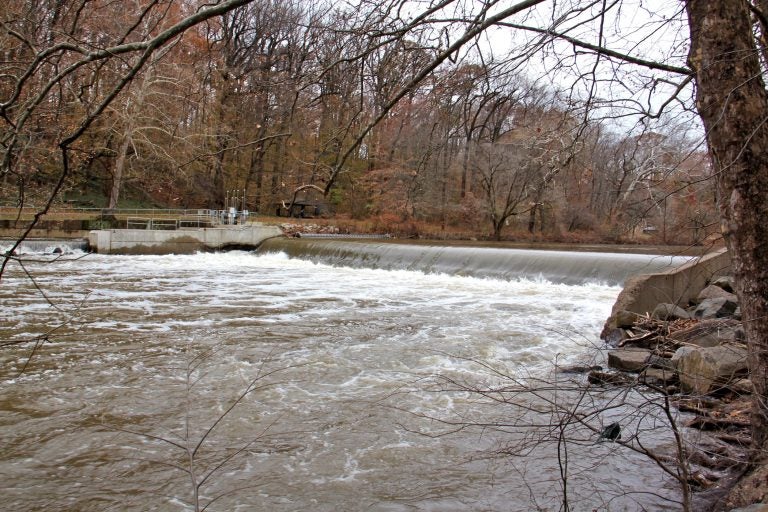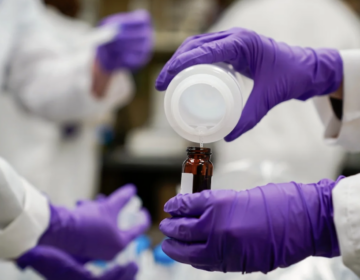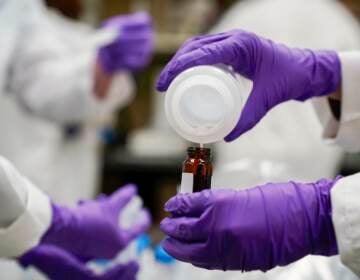Toxic PFAS detected in several Delaware watersheds, report says
Red Clay Creek, which provides drinking water for residents in the Stanton area, had some of the highest PFAS levels detected.
Listen 1:20
The Brandywine Creek in Wilmington, Delaware, shown here, is a tributary of the Christina River, which feeds into the Delaware River. (Emma Lee/WHYY)
From Philly and the Pa. suburbs to South Jersey and Delaware, what would you like WHYY News to cover? Let us know!
Toxic PFAS chemicals have been detected at significant levels across rivers and streams throughout Delaware, according to a state Department of Natural Resources and Environmental Control report released this week.
The agency sampled 33 of the state’s watersheds in the fall of 2022 and found varying levels of so-called “forever chemicals” among a majority of the rivers and streams analyzed. Six watersheds with the most concerning results have been prioritized for future research and mitigation.
“We certainly expected to see concentrations of PFAS in surface water … So, surprise, no. Concerned, sure. Any concentration will cause us in the jobs that we do to be concerned about it,” said DNREC hydrologist John Cargill. “But [the results] provide us the opportunity to focus our resources and prioritize … to try to tackle the biggest problems first.”
PFAS chemicals have tainted the water, air and soil across the country for decades. The chemicals have been widely used in consumer products such as nonstick cookware, waterproof clothing and some food packaging, as well as in firefighting foam.
Water supplies located near military bases and airports — from Bucks and Montgomery counties in Pennsylvania to the cities of New Castle and Dover in Delaware — have been particularly impacted by the historical use of firefighting foam. Residents in New Castle and elsewhere have exceedingly high levels of PFAS in their bloodstreams, according to studies.
Almost half of drinking water in the U.S. contains PFAS, according to the U.S. Geological Survey, and more than 70% of waterways in Pennsylvania alone contain the chemicals.
The consequences of exposure to PFAS are long-lasting — the compounds can stay in the environment, and the human bloodstream, for years. The chemicals have been linked to some cancers, thyroid disease, ulcerative colitis, developmental delays in children and other health conditions.
There have been numerous lawsuits against companies that manufacture and use the chemicals, such as DuPont and its successor companies and 3M, alleging they knew about the dangers as early as the 1960s.
‘Astounded’ by levels detected
After detecting high levels of PFAS, DNREC officials have prioritized six watersheds for further investigation and mitigation; Red Clay Creek in northern New Castle County, Hershey Run near Newport, Shellpot Creek in the Wilmington area, Long Branch near Greenwood, Little River near Dover and St. Jones River near Dover.
Red Clay Creek, which provides drinking water for residents in the Stanton area, had some of the highest PFAS levels detected — as high as 135 parts per trillion for one type of chemical. The area is home to chemical companies, however, the source of contamination in the creek has not been determined.
Utility company Veolia said a third of its drinking water supply at its Stanton plant is drawn from Red Clay. The water provider’s most recent test results show PFAS levels as high as 20 parts per trillion at the location, which serves more than 100,000 New Castle County residents.
Veolia is constructing a filtration system, which will reduce PFAS to non-detectable levels, a spokesman said.
Under new federal Environmental Protection Agency regulations, water providers must test and treat PFAS to below 4 parts per trillion over the next five years.
Veolia said it is not possible to determine whether PFAS contamination in the Red Clay has made its way to its Stanton plant.
Some of the highest PFAS levels were in Hershey Run stream near Newport, where various types of “forever chemicals” ranged from almost zero to more than 1,000 parts per trillion. The stream does not provide drinking water, however, and the extent of aquatic life is unclear.
Determining the source of the contamination in the six priority watersheds is crucial, said Seetha Coleman-Kammula, president and executive director of PFAS Solutions in Delaware, an organization that researches and provides guidance on testing and treatment solutions.
She said she was “astounded” by the levels detected in Hershey Run and added PFAS detected in Red Clay are similar to research conducted by her own organization finding levels above 50 parts per trillion for PFOA — one of the more common types of “forever chemical.”
“That should be the priority — find the source and remediate the problem, because it’s only going to get worse,” Coleman-Kammula said. “If you don’t know the source, you cannot take action to stop the contamination or remove the contamination.”
DNREC’s Cargill said while the study did not examine direct impacts, or the sources of contamination, the results will help the state prioritize resources. He said the next step is to conduct additional testing and determine potential sources of contamination.
“We want everybody to understand where they could potentially be exposed to PFAS chemicals, whether that be through their drinking water, through the activities they do outdoors, through the food that they eat, or any number of other potential exposure pathways,” Cargill said. “This is just one piece to a very big and confusing puzzle. And as we learn more about or define a little bit more about the different pieces to the puzzle, we want to share that with the public.”
Cargill added DNREC is working with the EPA to determine whether a nearby superfund site is contributing to the PFAS levels detected in Long Branch near Greenwood.
Coleman-Kammula said while the study is an important first step, the state should provide the public a better explanation about the potential risks associated with the levels of PFAS detected in the state’s surface water and lay out an action plan.
“Any time regulators come out and say, ‘We did the measurements,’ they’ve got to say something about, ‘We’re going to do this in X amount of time,’” she said.

Get daily updates from WHYY News!
WHYY is your source for fact-based, in-depth journalism and information. As a nonprofit organization, we rely on financial support from readers like you. Please give today.







